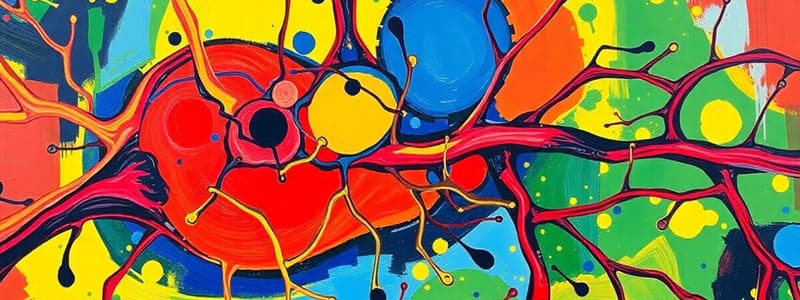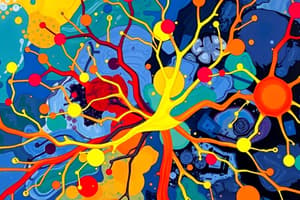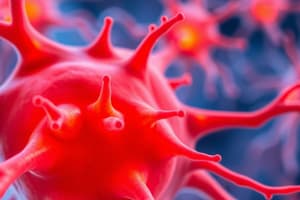Podcast
Questions and Answers
What type of synapse is formed between a neuron and a muscle cell?
What type of synapse is formed between a neuron and a muscle cell?
- Axodendritic synapse
- Electrical synapse
- Neuromuscular junction (correct)
- Chemical synapse
Which type of synapse allows for the fastest transmission of signals?
Which type of synapse allows for the fastest transmission of signals?
- Axosomatic synapse
- Chemical synapse
- Axoaxonic synapse
- Electrical synapse (correct)
What is the primary function of neurotransmitters at chemical synapses?
What is the primary function of neurotransmitters at chemical synapses?
- To create gap junctions
- To bind with receptors on the postsynaptic neuron (correct)
- To maintain ion balance
- To trigger an action potential
What type of junction is primarily responsible for forming electrical synapses?
What type of junction is primarily responsible for forming electrical synapses?
The distance between cells in an electrical synapse is typically how many nanometers?
The distance between cells in an electrical synapse is typically how many nanometers?
Which type of synapse involves a synaptic cleft that ranges from 20-40 nanometers?
Which type of synapse involves a synaptic cleft that ranges from 20-40 nanometers?
Which of the following describes the role of calcium ions in chemical synapses?
Which of the following describes the role of calcium ions in chemical synapses?
What is the area of the postsynaptic structure referred to as in a neuromuscular junction?
What is the area of the postsynaptic structure referred to as in a neuromuscular junction?
What is the primary effect of botulinum toxin on muscle contraction?
What is the primary effect of botulinum toxin on muscle contraction?
Which SNARE protein is specifically destroyed by Botulinum toxin A?
Which SNARE protein is specifically destroyed by Botulinum toxin A?
Which of the following is a clinical use of botulinum toxin?
Which of the following is a clinical use of botulinum toxin?
What is a common source of botulinum toxin infection?
What is a common source of botulinum toxin infection?
What role does acetylcholine play in the central nervous system?
What role does acetylcholine play in the central nervous system?
What condition is characterized by autoantibodies destroying voltage-gated Ca2+ channels?
What condition is characterized by autoantibodies destroying voltage-gated Ca2+ channels?
What is one major difference between electrical and chemical synapses?
What is one major difference between electrical and chemical synapses?
What is the mechanism of action of tetanus toxin?
What is the mechanism of action of tetanus toxin?
How does myasthenia gravis lead to muscle weakness?
How does myasthenia gravis lead to muscle weakness?
Which protein is classified as a V-SNARE?
Which protein is classified as a V-SNARE?
How do V-SNARE and T-SNARE proteins contribute to neurotransmitter release?
How do V-SNARE and T-SNARE proteins contribute to neurotransmitter release?
What compound is derived from tropical plants and has muscle relaxant properties?
What compound is derived from tropical plants and has muscle relaxant properties?
Which condition is known to affect neuromuscular junction function?
Which condition is known to affect neuromuscular junction function?
What is the mechanism of action of botulinum toxin?
What is the mechanism of action of botulinum toxin?
What characterizes the transmission speed of electrical synapses compared to chemical synapses?
What characterizes the transmission speed of electrical synapses compared to chemical synapses?
What effect does synaptotagmin have in the SNARE complex?
What effect does synaptotagmin have in the SNARE complex?
What initiates the opening of voltage-gated Ca+2 channels in the presynaptic neuron?
What initiates the opening of voltage-gated Ca+2 channels in the presynaptic neuron?
What causes neurotransmitter release into the synaptic cleft?
What causes neurotransmitter release into the synaptic cleft?
Which neurotransmitter is primarily responsible for excitatory signaling in the CNS?
Which neurotransmitter is primarily responsible for excitatory signaling in the CNS?
How does the binding of Ach to nAcHR affect ion flow in the postsynaptic cell?
How does the binding of Ach to nAcHR affect ion flow in the postsynaptic cell?
What is the nature of the motor end plate potential formed when Ach binds to nAcHR?
What is the nature of the motor end plate potential formed when Ach binds to nAcHR?
What effect does an accumulation of excitatory postsynaptic potentials (EPP) have on the neuronal membrane?
What effect does an accumulation of excitatory postsynaptic potentials (EPP) have on the neuronal membrane?
Which of the following channels opens as a result of reaching the threshold potential in the subneural parts of the membrane?
Which of the following channels opens as a result of reaching the threshold potential in the subneural parts of the membrane?
What role does GABA play in the central nervous system?
What role does GABA play in the central nervous system?
What effect does curare have at the neuromuscular junction?
What effect does curare have at the neuromuscular junction?
What is the role of excitatory neurotransmitters in the generation of EPSP?
What is the role of excitatory neurotransmitters in the generation of EPSP?
What happens to acetylcholine due to the action of curare?
What happens to acetylcholine due to the action of curare?
Which neurotransmitter is primarily associated with generating IPSP?
Which neurotransmitter is primarily associated with generating IPSP?
What is required for a postsynaptic neuron to reach the action potential threshold?
What is required for a postsynaptic neuron to reach the action potential threshold?
Which process involves multiple presynaptic neurons sending signals to a single postsynaptic neuron?
Which process involves multiple presynaptic neurons sending signals to a single postsynaptic neuron?
What immediate result occurs when Na channels open in a postsynaptic neuron?
What immediate result occurs when Na channels open in a postsynaptic neuron?
What happens to the postsynaptic neuron when the total of IPSP exceeds EPSP?
What happens to the postsynaptic neuron when the total of IPSP exceeds EPSP?
Flashcards
Synapse
Synapse
The connection between a neuron and another functional cell.
Neuromuscular Junction
Neuromuscular Junction
A synapse where the presynaptic neuron is a neuron and the postsynaptic cell is a muscle cell.
Presynaptic Cell
Presynaptic Cell
The neuron sending information across the synapse.
Postsynaptic Cell
Postsynaptic Cell
Signup and view all the flashcards
Axodendritic Synapse
Axodendritic Synapse
Signup and view all the flashcards
Axosomatic Synapse
Axosomatic Synapse
Signup and view all the flashcards
Axoaxonic Synapse
Axoaxonic Synapse
Signup and view all the flashcards
Electrical Synapse
Electrical Synapse
Signup and view all the flashcards
Synaptic Transmission
Synaptic Transmission
Signup and view all the flashcards
Presynaptic Neuron
Presynaptic Neuron
Signup and view all the flashcards
Neurotransmitters
Neurotransmitters
Signup and view all the flashcards
Motor End Plate Potential (MEPP)
Motor End Plate Potential (MEPP)
Signup and view all the flashcards
Ligand-gated Ion Channel
Ligand-gated Ion Channel
Signup and view all the flashcards
Glutamate
Glutamate
Signup and view all the flashcards
Acetylcholine
Acetylcholine
Signup and view all the flashcards
Chemical Synapse
Chemical Synapse
Signup and view all the flashcards
V-SNAREs
V-SNAREs
Signup and view all the flashcards
T-SNAREs
T-SNAREs
Signup and view all the flashcards
SNARE Complex
SNARE Complex
Signup and view all the flashcards
Botulinum Toxin
Botulinum Toxin
Signup and view all the flashcards
Botulinum Toxin: How does it work?
Botulinum Toxin: How does it work?
Signup and view all the flashcards
Botulinum Toxin: Mechanism of Action
Botulinum Toxin: Mechanism of Action
Signup and view all the flashcards
Botulinum Toxin: Clinical Uses
Botulinum Toxin: Clinical Uses
Signup and view all the flashcards
Tetanus Toxin: Mechanism of Action
Tetanus Toxin: Mechanism of Action
Signup and view all the flashcards
Lambert-Eaton Syndrome: Cause
Lambert-Eaton Syndrome: Cause
Signup and view all the flashcards
Myasthenia Gravis: Cause
Myasthenia Gravis: Cause
Signup and view all the flashcards
Curare: Mechanism of Action
Curare: Mechanism of Action
Signup and view all the flashcards
Postsynaptic potential
Postsynaptic potential
Signup and view all the flashcards
EPSP (Excitatory Postsynaptic Potential)
EPSP (Excitatory Postsynaptic Potential)
Signup and view all the flashcards
IPSP (Inhibitory Postsynaptic Potential)
IPSP (Inhibitory Postsynaptic Potential)
Signup and view all the flashcards
Convergence
Convergence
Signup and view all the flashcards
Divergence
Divergence
Signup and view all the flashcards
Summation
Summation
Signup and view all the flashcards
Synaptic facilitation
Synaptic facilitation
Signup and view all the flashcards
Study Notes
Nervous System Physiology Essentials 3
- This chapter covers the fundamentals of synapses, specifically neuromuscular junctions, and different synapse types, including electrical and chemical synapses, along with various neurotransmitters.
Synapse
- A synapse is the connection between two neurons, a neuron and a muscle cell, or a neuron and a gland cell.
- In the CNS, both cells involved in a synapse are neurons.
- In the PNS, either a neuron, muscle, or gland cell can be the second cell.
- The synapse between a neuron and a muscle cell is called a neuromuscular junction (NMJ).
Presynaptic and Postsynaptic Cells
- The cell before the synapse is the presynaptic cell.
- The cell behind the synapse is the postsynaptic cell.
Muscle Neuromuscular Junction
- The presynaptic cell is the neuron.
- The postsynaptic cell is the muscle cell.
Synapse Types (Structural)
- Axodendritic: Neuron to dendrite
- Axosomatic: Neuron to cell body
- Axoaxonic: Neuron to axon
Synapse Types (Functional)
- Excitatory: Stimulate the postsynaptic cell.
- Inhibitory: Suppress the postsynaptic cell.
Electrical Synapse
- Direct connection between neurons.
- Ions flow freely through gap junctions between cells.
- Transmission is very fast and bidirectional.
- No synaptic delay.
- Found in smooth muscle and heart muscle.
- Gap junctions are relatively close (2-4 nm).
Chemical Synapse
- Indirect connection between neurons.
- Neurotransmitters are released from the presynaptic neuron to transmit signals across a synaptic cleft.
- Transmission is unidirectional (one way).
- Synaptic delay exists (time it takes for neurotransmitter release and receptor binding).
- Found in most synapses in the nervous system.
- Synaptic cleft is wider, 20-40 nm apart.
Neurotransmitters
- Chemical messengers that transmit signals between neurons.
- Stored in synaptic vesicles in the presynaptic neuron.
- Released via exocytosis when an action potential reaches the axon terminal of the presynaptic neuron.
- Bind to receptors on the postsynaptic cell, initiating a response.
- Examples: Glutamate, GABA, Acetylcholine.
Neurotransmitters and Their Functions in CNS
- Glutamate: Excitatory, crucial for learning and memory.
- GABA: Inhibitory, plays a role in reducing anxiety.
- Acetylcholine: Excitatory, important for muscle contractions, learning, and memory.
Conditions Affecting the Neuromuscular Junction
- Lambert-Eaton Syndrome: Autoimmune disease affecting voltage-gated Ca2+ channels, reducing acetylcholine release.
- Botulism: Blocks the release of acetylcholine, leading to muscle paralysis.
- Tetanus: Blocks the release of inhibitory neurotransmitters causing overactivity of motor neurons, leading to muscle contraction.
- Myasthenia Gravis: Autoantibodies attack acetylcholine receptors at the neuromuscular junction decreasing its function.
- Curare: Competes with acetylcholine for receptor sites, blocking muscle stimulation.
Botulinum toxin (Botox)
- Released by Clostridium botulinum.
- Blocks the release of acetylcholine.
- Used to treat wrinkles, muscle spasms, and other conditions.
Common Ways to Get Botulism Toxin Infection
- Poorly preserved/sterilized/sealed homemade canned foods.
- Commercial foods.
- Honey (for infants as they lack bacteria in stomach for proper digestion)
Tetanus
- Caused by Clostridium tetani.
- Destroys synaptobrevin in inhibitory interneurons.
- Blocks release of inhibitory neurotransmitters.
- Leads to muscle contraction and spastic paralysis.
Lambert-Eaton Syndrome (LES)
- Autoimmune disease attacking voltage-gated Ca2+ channels in the presynaptic terminal.
- Less ACh release by presynaptic neuron.
- Leads to muscle weakness.
Myasthenia Gravis (MG)
- Autoimmune disease attacking ACh receptors.
- Less ACh reception.
- Causes muscle weakness.
Curare
- Plant-derived compound that blocks acetylcholine receptors.
- Causes muscle weakness/paralysis.
Postsynaptic Potentials
- EPSP (Excitatory Postsynaptic Potential): Makes it more likely that the postsynaptic neuron will fire. Increases membrane potential.
- IPSP (Inhibitory Postsynaptic Potential): Makes it less likely that the postsynaptic neuron will fire. Decreases membrane potential.
Summation
- Temporal Summation: Successive rapid stimuli from one presynaptic neuron.
- Spatial Summation: Simultaneous stimulation from multiple presynaptic neurons.
Convergence and Divergence
- Convergence: Multiple presynaptic neurons converging onto a single postsynaptic neuron (information from multiple sources collected in one place).
- Divergence: Information from one neuron diverging to multiple postsynaptic neurons (information from one source going to several).
- Facilitation: Temporary increase in the neuron's excitability from repeated stimulation/activation.
###V-SNARE and T-SNARE
- Proteins that are essential for neurotransmitter release from synaptic vesicles into the synaptic cleft. Essential for V-SNARE proteins and T-SNARE proteins to properly fuse.
Studying That Suits You
Use AI to generate personalized quizzes and flashcards to suit your learning preferences.




